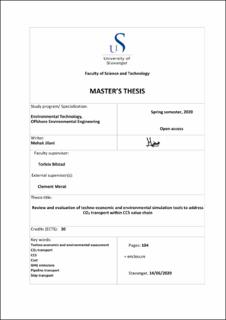| dc.contributor.advisor | Bilstad, Torleiv | |
| dc.contributor.author | Jilani, Mehak | |
| dc.coverage.spatial | Norway | en_US |
| dc.date.accessioned | 2021-01-28T09:23:51Z | |
| dc.date.available | 2021-01-28T09:23:51Z | |
| dc.date.issued | 2020-06-15 | |
| dc.identifier.uri | https://hdl.handle.net/11250/2725113 | |
| dc.description | Master's thesis in Environmental Technology | en_US |
| dc.description.abstract | Carbon capture and storage (CCS) is an important solution to meeting climate targets set by United Nations and can potentially reduce 15 % of CO2 emissions globally. CCS has been studied for over 20 years. However, its deployment rate is low due to challenges surrounding CCS costs for deployment and lack of awareness and importance of CCS in tackling climate change. To determine the viability of CCS chains, it is important to carry out techno-economic and environmental assessment over the lifecycle to identify potential cost optimization areas.
There are several tools that can be used for techno-economic and environmental impact assessment. Tool 1 was developed by a research institution in Norway. Two versions of this tool are available; Tool 1 (2012) and Tool 1 (2017). Tool 2 was developed by Energy consultancy agency based in the UK in partnership with research organizations and engineering companies in Netherlands and Norway. These tools were used to assess ongoing CCS Research and Development (R&D) activities and possible business cases to determine the accuracy of these tools and to identify the gaps within the tools. Tool 1 is able to assess different types of CO2 transport options (onshore/offshore pipeline, shipping between harbors and direct shipping to an offshore site), while Tool 2, originally developed for the UK region, focuses more on ship transport option.
Three key themes were investigated within this study. The first theme consisted of assessing and analyzing shipping transport at different pressures (7 bara and 15 bara) from which low-pressure (7 bara) ship transport was identified to be a cost-optimal solution for business cases studied. Based on analysis of ongoing projects, using both versions of Tool 1 it was shown that for shorter distances pipeline transport was cost optimal, compared to ship transport. For longer distances, ship transport was shown to be a better option. However, Tool 1 calculated the carbon footprint of ship transport to be greater than pipeline transport of CO2 regardless of the distance, mainly due to fuel consumption during travel and on-board reconditioning. Cost assessment results from Tool 2 provided a good insight on low pressure and medium pressure ship transport of CO2, presenting low pressure ship option as more economical. However, since medium pressure ships have size restrictions (up to 10000 m3) due to current design rules, ship sizes used by Tool 2 might not be feasible in practice. Tool 2 turned out to be more of a theoretical scenario tool based on different ship transport studies.
The second key theme consisted of investigating the potential benefits of re-using existing oil and gas infrastructure for transport and injection of CO2. Re-using existing pipelines can potentially reduce emissions by over 80 % and give cost savings of over 85 % compared to new built pipelines and ship transport of CO2 from one location to another provided that the challenges of re-use cases are overcome. Common parameters that have a significant impact on lifetime costs are flow rate, project duration, pipeline length and/or shipping distance according to parameter sensitivity analysis performed using Tool 1.
The third theme consisted of understanding the effect of pipeline dimensions on costs especially focusing on pipe diameter and wall thickness. For specific pipeline transport case, it is shown that changing pipeline diameter might have significant impact on total lifetime costs. For 10.75 and 12.75-inch pipeline, varying wall thickness in the range of ±50 % showed very limited benefit on costs of pipeline.
Overall, the study qualified Tool 1 for multicriteria analysis of CCS related projects compared to other publicly available tools. The results obtained using Tool 1 provided insights on areas of CO2 transport chain, where cost optimization can occur and helped with selecting cost-optimal transport options for ongoing projects and business cases. | en_US |
| dc.language.iso | eng | en_US |
| dc.publisher | University of Stavanger, Norway | en_US |
| dc.relation.ispartofseries | Masteroppgave/UIS-TN-IKBM/2020; | |
| dc.rights | Attribution-NoDerivatives 4.0 Internasjonal | * |
| dc.rights.uri | http://creativecommons.org/licenses/by-nd/4.0/deed.no | * |
| dc.subject | CO2 transport | en_US |
| dc.subject | CCS | en_US |
| dc.subject | Cost | en_US |
| dc.subject | GHG emissions | en_US |
| dc.subject | environmental technology | en_US |
| dc.subject | techno-economic and environmental assessment | en_US |
| dc.subject | pipeline transport | en_US |
| dc.subject | ship transport | en_US |
| dc.subject | miljøteknologi | en_US |
| dc.subject | karbonfangst | en_US |
| dc.title | Review and evaluation of techno-economic and environmental simulation tools to address CO2 transport within CCS value chain | en_US |
| dc.type | Master thesis | en_US |
| dc.subject.nsi | VDP::Teknologi: 500::Miljøteknologi: 610 | en_US |

